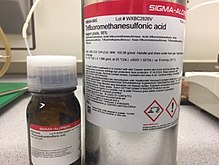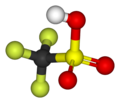Triflic acid

| |||
| |||
| Names | |||
|---|---|---|---|
| IUPAC name
Trifluoromethanesulfonic acid
| |||
| Other names
Triflic acid
| |||
| Identifiers | |||
3D model (
JSmol ) |
|||
| ChEBI | |||
| ChemSpider | |||
ECHA InfoCard
|
100.014.625 | ||
PubChem CID
|
|||
| UNII | |||
CompTox Dashboard (EPA)
|
|||
| |||
| |||
| Properties | |||
| CF3SO3H | |||
| Molar mass | 150.07121 g/mol | ||
| Appearance | Colorless liquid | ||
| Density | 1.696 g/mL | ||
| Melting point | −40 °C (−40 °F; 233 K) | ||
| Boiling point | 162 °C (324 °F; 435 K) | ||
| 1600 g/L | |||
| Vapor pressure | 3.2 | ||
| Acidity (pKa) | −14.7±2.0[1] | ||
Conjugate base
|
Triflate anion
| ||
| Viscosity | 1.864–1.881 mm2/s at 20 °C | ||
| Hazards | |||
| Occupational safety and health (OHS/OSH): | |||
Main hazards
|
Causes severe acid burns | ||
| GHS labelling: | |||
 
| |||
| Danger | |||
| H290, H302, H314, H335, H402 | |||
| P234, P261, P264, P270, P271, P273, P280, P301+P312+P330, P301+P330+P331, P303+P361+P353, P304+P340+P310, P305+P351+P338+P310, P363, P390, P403+P233, P405, P501 | |||
| NFPA 704 (fire diamond) | |||
Except where otherwise noted, data are given for materials in their standard state (at 25 °C [77 °F], 100 kPa).
| |||

Triflic acid, the short name for trifluoromethanesulfonic acid, TFMS, TFSA, HOTf or TfOH, is a
Synthesis
Trifluoromethanesulfonic acid is produced industrially by electrochemical fluorination (ECF) of methanesulfonic acid:
The resulting CF3SO2F is
Triflic acid is purified by
Historical
Trifluoromethanesulfonic acid was first synthesized in 1954 by Robert Haszeldine and Kidd by the following reaction:[5]
Reactions
As an acid
In the laboratory, triflic acid is useful in protonations because the conjugate base of triflic acid is nonnucleophilic. It is also used as an acidic titrant in nonaqueous acid-base titration because it behaves as a strong acid in many solvents (acetonitrile, acetic acid, etc.) where common mineral acids (such as HCl or H2SO4) are only moderately strong.
With a
Triflic acid fumes in moist air and forms a stable solid monohydrate, CF3SO3H·H2O, melting point 34 °C.
Salt and complex formation
The triflate ligand is labile, reflecting its low basicity. Trifluoromethanesulfonic acid reacts exothermically with metal carbonates, hydroxides, and oxides. Illustrative is the synthesis of Cu(OTf)2.[6]
Chloride ligands can be converted to the corresponding triflates:
This conversion is conducted in neat HOTf at 100 °C, followed by precipitation of the salt upon the addition of ether.
Organic chemistry
Triflic acid reacts with acyl halides to give mixed triflate anhydrides, which are strong acylating agents, e.g. in Friedel–Crafts reactions.
Triflic acid catalyzes the reaction of aromatic compounds with sulfonyl chlorides, probably also through the intermediacy of a mixed anhydride of the sulfonic acid.
Triflic acid promotes other Friedel–Crafts-like reactions including the cracking of alkanes and alkylation of alkenes, which are very important to the petroleum industry. These triflic acid derivative catalysts are very effective in isomerizing straight chain or slightly branched hydrocarbons that can increase the octane rating of a particular petroleum-based fuel.
Triflic acid reacts exothermically with alcohols to produce ethers and olefins.

Dehydration gives the acid anhydride, trifluoromethanesulfonic anhydride, (CF3SO2)2O.
Safety
Triflic acid is one of the strongest acids. Contact with skin causes severe burns with delayed tissue destruction. On inhalation it causes fatal spasms, inflammation and edema.[7]
Like sulfuric acid, triflic acid must be slowly added to
References
- ^ S2CID 29697201.
- .
- ^ ISBN 0-471-93623-5.
- ISBN 3527306730.
- .
- ISBN 978-0-470-13259-3.
- ^ "Trifluoromethanesulfonic acid MSDS". ChemCAS.







![{\displaystyle {\ce {C6H6 + H2SO4 ->[{\ce {SO3}}] C6H5(SO3H) + H2O}}}](https://wikimedia.org/api/rest_v1/media/math/render/svg/0171ff1338e1974d73935d46ca6110c9ad3f5c27)

![{\displaystyle {\ce {3 CF3SO3H + [Co(NH3)5Cl]Cl2 -> [Co(NH3)5O3SCF3](O3SCF3)2 + 3 HCl}}}](https://wikimedia.org/api/rest_v1/media/math/render/svg/16bc6679aa18a720c03cd65ce7033a8da12409f1)

